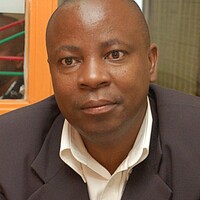Sand dams: Simple way to save water in Africa takes hold
| Nairobi, Kenya
The discovery of a lake the size of Delaware beneath a Kenyan desert this month may prove to be a game-changer for precious water needs in arid East Africa.
The new supply of billions of gallons, if managed properly, may make the desert bloom indefinitely, some scientists and UN experts say.
Yet in the mid-term, as Kenyan communities grapple with water shortages, many are starting to turn to something called “sand dams” to trap and save nature's precious liquid for use in times with no rain.
More than a thousand sand dams have been built in East Africa in the past decade in what is a simple, low-cost, effective way to store millions of gallons of water – by trapping it in piles of sand and later accessing it when rivers go dry.
Kenyans in the counties of Kitui, Machakos, and Makueni need water for crop irrigation, not to mention drinking. But their main rivers flow only seasonally.
Now, in a number of villages, local farmers are planting and harvesting all year long.
Sand dam technology may date to Roman times. But it has been perfected in the 21st century by a combination of talent including a British NGO called Excellent Development, the late Joshua Mukusya who made his start as a Kenyan farmer, and members of the Mennonite community of North America.
The dams are built by securing one or sometimes two long, reinforced concrete barriers across river beds, and by placing slotted PVC pipe deeper under the barriers. When it rains, the water carries sand downstream, depositing it up and around the level of the barrier.
At the end of the rainy season, water remains trapped in the piled-up sand, sometimes far downstream. Over time it drains into the PVC (a process that also helps with filtering and cleaning) and is then horded using a hand pump or a small run off pool – or in some cases a simple hole is dug at the base of the dam down to what has become a pool of stored water that can slake the thirst of 1,200 people for a year.
An average sand dam can store millions of gallons of water for years, and provide water for irrigation even when the rains fail, as noted at the first international conference on sand dams in Machakos, a town near Nairobi.
“We have literally turned arid and semi-arid lands into some of the most productive farmland. We continue to provide water to our community through the construction of sand dams,” said Kevin Kimuya, the chief executive officer of Utooni Development Organization, a sand dam NGO founded by Mr. Mukusya. “This forms the basis of local and International water and food security solution now and well into the future.”
The technology is in use across the world, from Brazil to Thailand. But under the Utooni group in Kenya, the idea has in recent year become a hot ticket in Ethiopia, Ghana, Mozambique, Burkina Faso, Somaliland, and Zimbabwe. Excellent Developers estimates that some 120 of the dams have been built in Kenya in recent years.
For several years, the Mennonite Central Committee (MCC) has supported its sister NGOs in organizing communities to complete the dams.
The Mennonites, according to Ron Ratzlaff, a representative of the Mennonite council, are helping with sand dams as part of a peace theology that seeks “to remove threats that advance war and conflict, water being one of them.”
The Mennonites work with Canadian Foodgrains Bank which fights global hunger as well as the US Food Resource Bank, which funds local farmers’ efforts against hunger.
“This is not just about sand dams. It is much more than sand dams. It is about trees and terraces…drought resistant crops…conservation agriculture. It is about a whole bunch of things that get added in at the value chain associated with water,” says Mr. Ratzlaff.
Jesse Mugambi, an ecologist at the University of Nairobi, argues that sand dam construction is the most economical method of rehabilitating semi-arid lands wherever rain runoff includes both sand and water.
The dams’ construction combined with terracing and reforestation restores degraded land within less than a generation, he told the international conference. “Sand can carry water, store it, filter it, cool it, preserve it, and prevent it from evaporation,” Prof. Mugambi adds.





